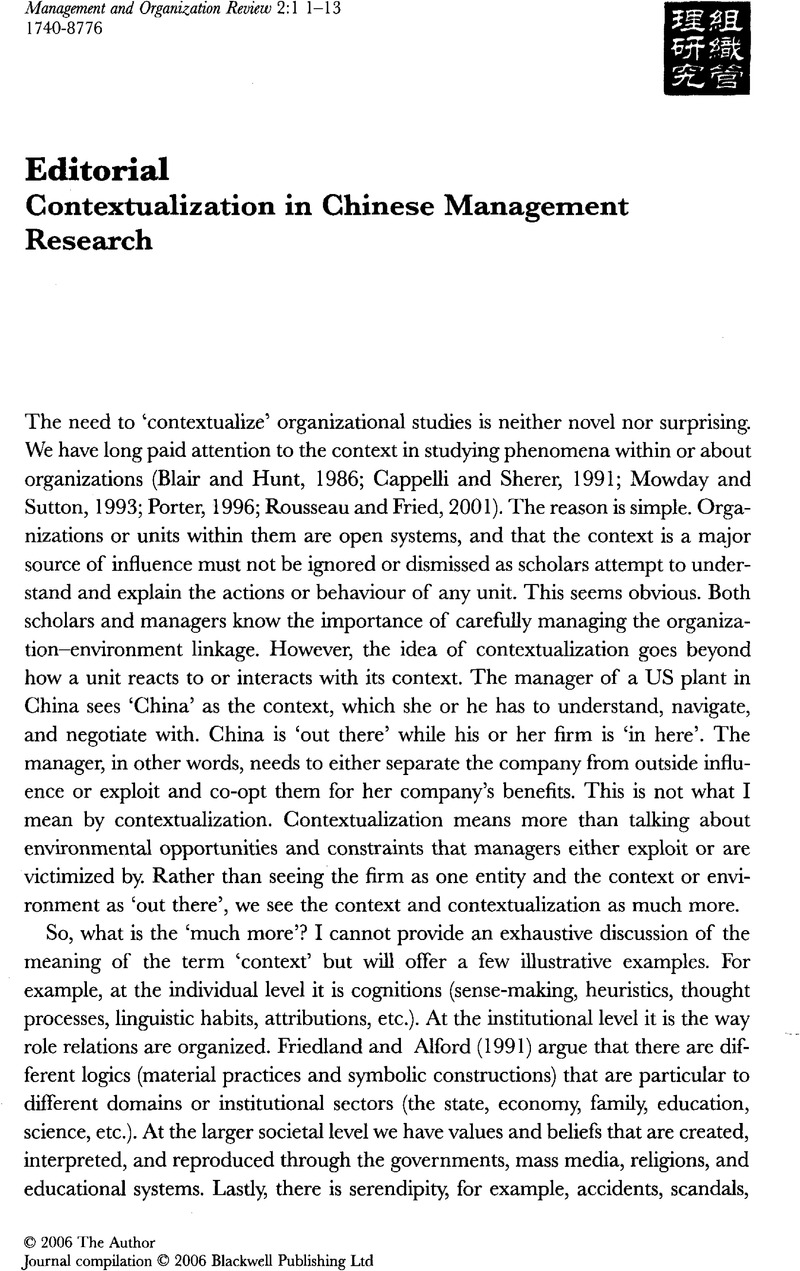Crossref Citations
This article has been cited by the following publications. This list is generated based on data provided by Crossref.
Zhang, Kai
Song, Lynda Jiwen
Hackett, Rick D.
and
Bycio, Peter
2006.
Cultural Boundary of Expectancy Theory-Based Performance Management: A Commentary on DeNisi and Pritchard's Performance Improvement Model.
Management and Organization Review,
Vol. 2,
Issue. 2,
p.
279.
Farh, Jiing-Lih
Cannella, Albert A.
and
Lee, Cynthia
2006.
Approaches to Scale Development in Chinese Management Research.
Management and Organization Review,
Vol. 2,
Issue. 3,
p.
301.
Farh, Jiing-Lih Larry
Cannella, Albert A. A.
and
Lee, Cynthia
2006.
Approaches to Scale Development in Chinese Management Research.
SSRN Electronic Journal,
Tsui, Anne S.
Zhao, Shuming
and
Abrahamson, Eric
2007.
What to Study in China? Choosing and Crafting Important Research Questions.
Management and Organization Review,
Vol. 3,
Issue. 2,
p.
171.
Leung, Kwok
2007.
The Glory and Tyranny of Citation Impact: An East Asian Perspective.
Academy of Management Journal,
Vol. 50,
Issue. 3,
p.
510.
Bruton, Garry D.
Dess, Gregory G.
and
Janney, Jay J.
2007.
Knowledge management in technology-focused firms in emerging economies: Caveats on capabilities, networks, and real options.
Asia Pacific Journal of Management,
Vol. 24,
Issue. 2,
p.
115.
Peng, Mike W.
Zhang, Shujun
and
Li, Xinchun
2007.
CEO Duality and Firm Performance during China's Institutional Transitions.
Management and Organization Review,
Vol. 3,
Issue. 2,
p.
205.
Wang, Yue
and
Nicholas, Stephen
2007.
The formation and evolution of non-equity strategic alliances in China.
Asia Pacific Journal of Management,
Vol. 24,
Issue. 2,
p.
131.
Xiao, Zhixing
and
Tsui, Anne S.
2007.
When Brokers May Not Work: The Cultural Contingency of Social Capital in Chinese High-tech Firms.
Administrative Science Quarterly,
Vol. 52,
Issue. 1,
p.
1.
Galaskiewicz, Joseph
2007.
Has a Network Theory of Organizational Behaviour Lived Up to its Promises?.
Management and Organization Review,
Vol. 3,
Issue. 1,
p.
1.
Peng, Mike W.
2007.
Globalizing the Asia Pacific Journal of Management.
Asia Pacific Journal of Management,
Vol. 24,
Issue. 1,
p.
1.
Shapiro, Debra L.
Glinow, Mary Ann Von
and
Xiao, Zhixing
2007.
Toward Polycontextually Sensitive Research Methods.
Management and Organization Review,
Vol. 3,
Issue. 1,
p.
129.
Tsui, Anne S.
2007.
From Homogenization to Pluralism: International Management Research in the Academy and Beyond.
Academy of Management Journal,
Vol. 50,
Issue. 6,
p.
1353.
Tsui, Anne S.
2007.
Taking Stock and Looking Ahead: MOR and Chinese Management Research.
Management and Organization Review,
Vol. 3,
Issue. 3,
p.
327.
Tsui, Anne S.
Nifadkar, Sushil S.
and
Amy Yi Ou
2007.
Cross-National, Cross-Cultural Organizational Behavior Research: Advances, Gaps, and Recommendations.
Journal of Management,
Vol. 33,
Issue. 3,
p.
426.
Zhu, Cherrie Jiuhua
Thomson, S. Bruce
and
Cieri, Helen De
2008.
A retrospective and prospective analysis of HRM research in Chinese firms: Implications and directions for future study.
Human Resource Management,
Vol. 47,
Issue. 1,
p.
133.
Chen, Zhen Xiong
Tsui, Anne S.
and
Zhong, Lifeng
2008.
Reactions to psychological contract breach: a dual perspective.
Journal of Organizational Behavior,
Vol. 29,
Issue. 5,
p.
527.
Lo, Carlos W H
Egri, Carolyn P
and
Ralston, David A
2008.
Commitment to corporate, social, and environmental responsibilities: an insight into contrasting perspectives in China and the US.
Organization Management Journal,
Vol. 5,
Issue. 2,
p.
83.
Liu, Bangcheng
Tang, Ningyu
and
Zhu, Xiaomei
2008.
Public service motivation and job satisfaction in China.
International Journal of Manpower,
Vol. 29,
Issue. 8,
p.
684.
Chen, Xiao-Ping
and
Peng, Siqing
2008.
Guanxi Dynamics: Shifts in the Closeness of Ties Between Chinese Coworkers.
Management and Organization Review,
Vol. 4,
Issue. 1,
p.
63.





